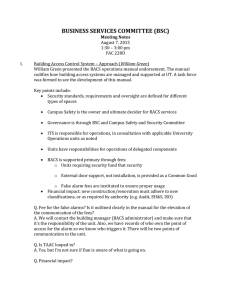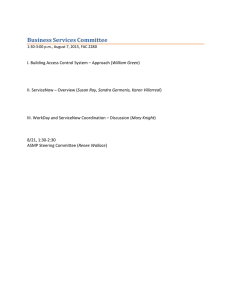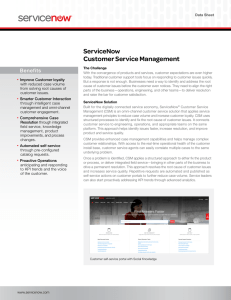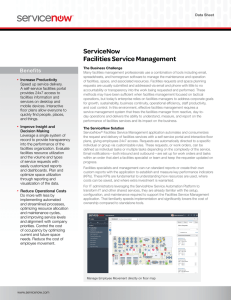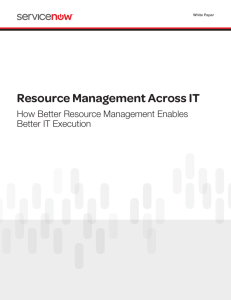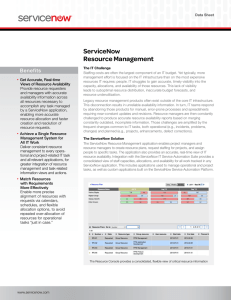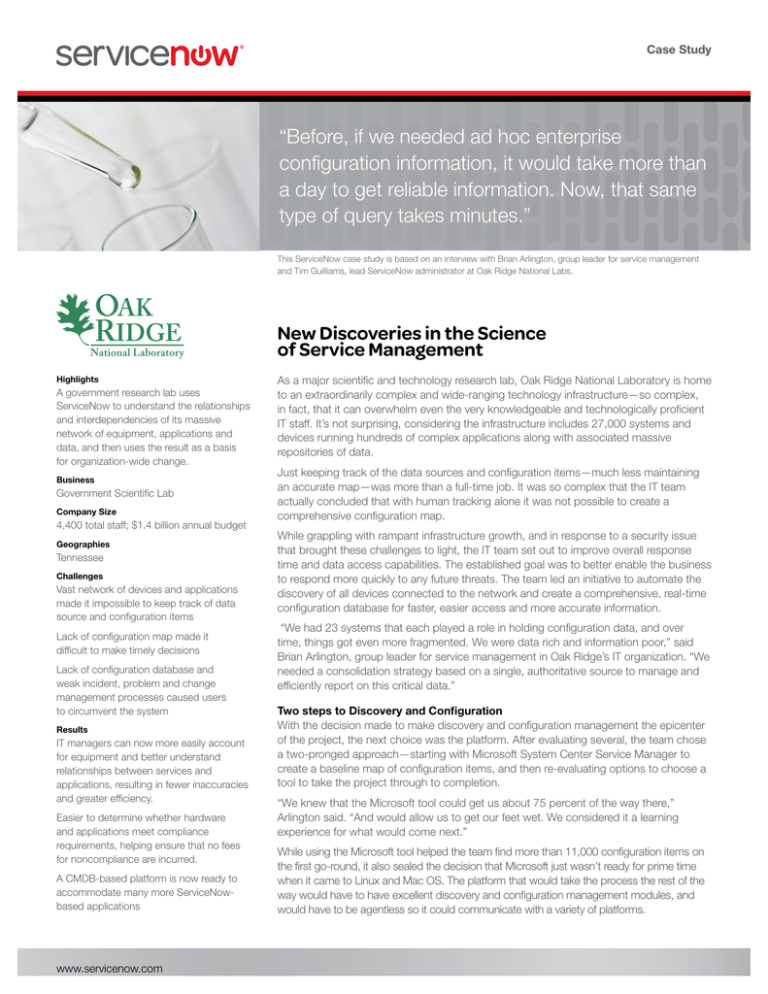
Case Study
“Before, if we needed ad hoc enterprise
configuration information, it would take more than
a day to get reliable information. Now, that same
type of query takes minutes.”
This ServiceNow case study is based on an interview with Brian Arlington, group leader for service management
and Tim Guilliams, lead ServiceNow administrator at Oak Ridge National Labs.
New Discoveries in the Science
of Service Management
Highlights
A government research lab uses
ServiceNow to understand the relationships
and interdependencies of its massive
network of equipment, applications and
data, and then uses the result as a basis
for organization-wide change.
Business
Government Scientific Lab
Company Size
4,400 total staff; $1.4 billion annual budget
Geographies
Tennessee
Challenges
Vast network of devices and applications
made it impossible to keep track of data
source and configuration items
Lack of configuration map made it
difficult to make timely decisions
Lack of configuration database and
weak incident, problem and change
management processes caused users
to circumvent the system
Results
IT managers can now more easily account
for equipment and better understand
relationships between services and
applications, resulting in fewer inaccuracies
and greater efficiency.
Easier to determine whether hardware
and applications meet compliance
requirements, helping ensure that no fees
for noncompliance are incurred.
A CMDB-based platform is now ready to
accommodate many more ServiceNowbased applications
www.servicenow.com
As a major scientific and technology research lab, Oak Ridge National Laboratory is home
to an extraordinarily complex and wide-ranging technology infrastructure—so complex,
in fact, that it can overwhelm even the very knowledgeable and technologically proficient
IT staff. It’s not surprising, considering the infrastructure includes 27,000 systems and
devices running hundreds of complex applications along with associated massive
repositories of data.
Just keeping track of the data sources and configuration items—much less maintaining
an accurate map—was more than a full-time job. It was so complex that the IT team
actually concluded that with human tracking alone it was not possible to create a
comprehensive configuration map.
While grappling with rampant infrastructure growth, and in response to a security issue
that brought these challenges to light, the IT team set out to improve overall response
time and data access capabilities. The established goal was to better enable the business
to respond more quickly to any future threats. The team led an initiative to automate the
discovery of all devices connected to the network and create a comprehensive, real-time
configuration database for faster, easier access and more accurate information.
“We had 23 systems that each played a role in holding configuration data, and over
time, things got even more fragmented. We were data rich and information poor,” said
Brian Arlington, group leader for service management in Oak Ridge’s IT organization. “We
needed a consolidation strategy based on a single, authoritative source to manage and
efficiently report on this critical data.”
Two steps to Discovery and Configuration
With the decision made to make discovery and configuration management the epicenter
of the project, the next choice was the platform. After evaluating several, the team chose
a two-pronged approach—starting with Microsoft System Center Service Manager to
create a baseline map of configuration items, and then re-evaluating options to choose a
tool to take the project through to completion.
“We knew that the Microsoft tool could get us about 75 percent of the way there,”
Arlington said. “And would allow us to get our feet wet. We considered it a learning
experience for what would come next.”
While using the Microsoft tool helped the team find more than 11,000 configuration items on
the first go-round, it also sealed the decision that Microsoft just wasn’t ready for prime time
when it came to Linux and Mac OS. The platform that would take the process the rest of the
way would have to have excellent discovery and configuration management modules, and
would have to be agentless so it could communicate with a variety of platforms.
New Discoveries in the Science of Service Management
ServiceNow fit the bill—not only as a
platform to finish the massive discovery
and configuration management phase,
but as a foundation for everything else
Arlington’s staff wanted to do, from
replacing aging incident, problem and
change processes to automating and
transforming other business services
throughout the organization.
“Before, if we asked a simple question
like ‘Which machines have access to the
Internet and are running versions 8, 9 or
10 of Cold Fusion’, it would take more
than a day to get reliable information—so
long that the information couldn’t be
used to make timely decisions,” Arlington
explained. “Now that same type of query
takes less than an hour.”
Conquering complexity
Starting with a fairly well-developed
configuration item map, the IT group
engaged the ServiceNow Professional
Services team to define requirements, and
then began working together to build out
the discovery schedules.
“Other groups have been asking for
access to the CMDB data and realize the
powerful insight it can provide into each
device,” Guilliams says. “Even something
as simple as not having to go down to the
data center to find a barcode on the back
of a machine to get a serial number is a
big efficiency benefit.”
“The level of engagement from the
ServiceNow Professional Services
team is probably the best I’ve ever
worked with,” said Tim Guilliams, lead
ServiceNow administrator at Oak Ridge
National Labs. “We have an extremely
complex environment, and they picked
it up extremely fast. They were also
able to provide some insights on best
practices that proved very valuable and
led to a faster time to market. And most
importantly, they were as excited by what
we were doing as we were.”
It was a complicated endeavor with more
than 700 discovery schedules across five
networks, and more than 900 vLANs.
Together, the two teams finished the entire
Configuration Management database
(CMDB) phase in less than three months.
“When we laid out these plans, we didn’t
think we could deliver a CMDB in a three
month window,” Arlington said. “We
exceeded our own expectations.”
Once complete, the configuration
database quickly became indispensible.
Extending Innovation Across and
Outside of IT
With the foundation set, the next
phase consisted of replacing legacy
systems for incident, problem and
change management with ServiceNow
applications. This has allowed the IT staff
to better track progress based on true
Service Level Agreements (SLA) set with
their customers and to better analyze
where improvements need to be made.
“It was critical to have the base at the
CMDB level first, because it makes the
incident, problem and change processes
rich enough that people will want to use it,
instead of having to use it,” Gulliams said.
“And that’s what has happened; people
can see how making a change to one
thing will impact other activities.”
With basic ITSM functions running
smoothly and the CMDB database
proving its worth every day, Arlington’s
team has moved to the next phase—
improving Oak Ridge’s help desk, which
it calls Solution Center.
Case Study
“We were data rich
and information
poor when it comes
to enterprise
configuration
information. Clearly,
we needed a
single authoritative
source of timely
and detailed
configuration data,
and a simple way to
mine it for various
purposes.”
Products
ServiceNow® Configuration
Management (CMDB)
ServiceNow® Discovery
ServiceNow®
Incident Management
ServiceNow®
Change Management
ServiceNow®
Problem Management
New Discoveries in the Science of Service Management
“We wanted to be able to give people
one number to call to get information on
anything,” Arlington explained. “If they
are a researcher, they might ask where
to get instrumentation, and if they are a
visitor, they might want to know how to
get through a guard gate. These are the
opportunities with the ServiceNow platform
that are really exciting as we can deliver
a portfolio of automated services that will
increase efficiencies across our facility and
touch every employee.”
Also on the docket is being able to support
other organizations within Oak Ridge, such
as human resources, training or finance.
Ultimately, Arlington plans to replace those
siloed request systems with applications
from ServiceNow.
Case Study
“The level of
engagement from
the ServiceNow
Professional
Services team was
among the best I’ve
ever worked with.”
www.servicenow.com
©2014 ServiceNow, Inc. All rights reserved.
ServiceNow believes information in this publication is accurate as of its publication date. This publication could include technical inaccuracies or typographical errors. The information is subject to change
without notice. Changes are periodically added to the information herein; these changes will be incorporated in new additions of the publication. ServiceNow may make improvements and/or changes in
the product(s) and/or the program(s) described in this publication at any time. Reproduction of this publication without prior written permission is forbidden. The information in this publication is provided
“as is”. ServiceNow makes no representations or warranties of any kind, with respect to the information in this publication, and specifically disclaims implied warranties of merchantability or fitness for a
particular purpose.
ServiceNow is a trademark of ServiceNow, Inc. All other brands, products, service names, trademarks or registered trademarks are used to identify the products or services of their respective owners.

